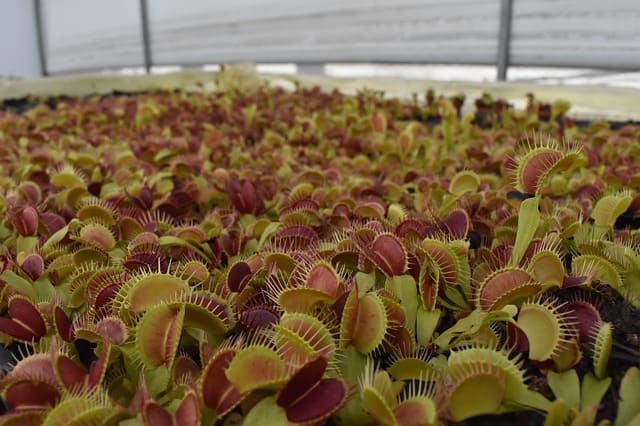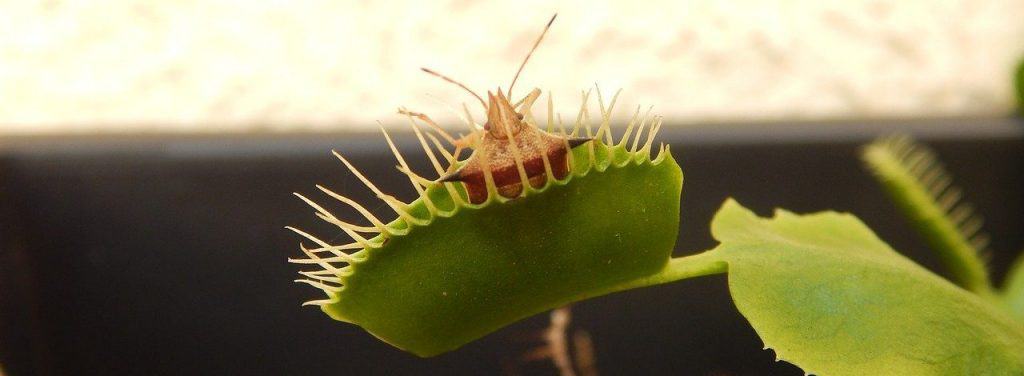Venus flytrap = Man-eating plant?
Venus flytraps are fascinating carnivorous plants. Their leaves have evolved to look like jawlike structures that trap prey. When most people encounter a Venus flytrap for the first time, they are fascinated by the traps. Let’s say you run into a Venus flytrap. Is it safe to touch the trap? Or maybe to stick your finger inside a trap? Can Venus flytrap hurt humans?
First of all, poking the plant or inserting your finger might not be the best idea ( I will explain in just a bit!). Yet, Venus flytrap cannot hurt humans. You won’t lose a finger or even get a scratch if a trap closes on your pinky.

How safe are Venus flytraps?
They are very safe. The trapping mechanism in Venus flytraps is designed to detect motion inside the leaves and activate the trap. You can easily trigger a Venus flytrap and get your finger stuck in the leaves. However, it won’t really be trapped because of two main reasons: size and strength.
First, Venus flytraps are small plants. The expected mature width size of Venus flytraps is 5 inches (12.7 cm) in diameter. Vertically, Venus flytraps can be as tall as a foot (30 cm). And, the size of a single trap is about 1 inch long.
You might have watched science fiction movies with life-size carnivorous plants. But, Venus flytraps are small plants that grow close to the ground. In the wild, Venus flytraps are predatory plants. They are always waiting patiently for the next victim. But those victims are just small bugs.
Second, the strength of a Venus flytrap is not enough to trap a human. The traps are designed to catch small bugs. Venus flytraps aim to catch prey that can fit inside a single trap completely. They do not have the strength to hold a larger victim.
Can a Venus flytrap make you bleed?
Venus flytraps close their traps at high speed. The initial action of closing is swift, yet not strong enough for a human to notice. You will feel pressure, but nothing beyond that.
Some people exaggerate the strength of Venus flytraps. They claim that Venus flytraps can make you bleed. This claim is untrue. The traps are not sharp; therefore, they can’t cut you. And, again, they are not strong enough to make you bleed.
“Venus flytraps exhibit one of the fastest movements in the plant kingdom, competing in speed tests with the exploding fruits of flowering plants.” (Robin Lloyd, Live Science, Venus Flytrap’s Speed Secret Revealed)
Can Venus flytraps eat a human?
On rare occasions, mature Venus flytraps can catch small rodents or small frogs. If the prey is small enough, and if it stays within the trap, the plant can consume it. It will start the digestion process inside the trap by producing enzymes. The enzymes can slowly break up the victim’s body.
 But, if Venus flytraps can consume flesh, can’t they consume a human? They cannot consume a human (or at least not a significant part of it).
But, if Venus flytraps can consume flesh, can’t they consume a human? They cannot consume a human (or at least not a significant part of it).
You can take a small piece of skin and give it to a Venus flytrap. The plant should be able to digest it. Yet, the plant can’t consume anything more significant than that.
The standard digestion process takes one to two weeks for a small bug. It takes longer for larger prey. And, if the plant attempts to consume an even larger victim, the trap will most likely die. When prey is too big for the trap, and the trap is unable to consume it within a reasonable timeline, the trap will start dying. It will turn black and wither completely.
If you go ahead and stick your finger inside a Venus flytrap and do not remove it for days, you will notice some changes…
However, these will be minor. The skin in your finger might look yellowish due to the contact with the enzymes. Also, some of your skin might have peeled off. This would be a big deal if you were a miniature frog, but at a human scale, it would just be a scratch. Still, it is probably not the best (or most fun) idea to confirm the effects.
Why you shouldn’t stick your finger inside a Venus flytrap (not because it hurts)
Generally, when you encounter Venus flytraps, you should avoid triggering the traps with your fingers. Venus flytraps employ a good amount of energy, activating those traps. The energy loss won’t kill them immediately, but it will weaken the plant.
Instead of triggering the traps with your finger, you can observe the trapping mechanism by feeding the plant. Venus flytraps use the nutrients from bugs they catch and consume to supplement their diet and thrive. Therefore, the plants will be very thankful if you feed them.
It is amusing to watch these plants in action! We have a full article that teaches you how to feed a Venus flytrap. The article suggests prey options and the best methods to keep Venus flytraps healthy. Make sure to give it a read before you feed a Venus flytrap.
Are Venus flytraps dangerous for humans?
I hope the message is clear: Venus flytrap cannot hurt us; they are inoffensive to humans. And they are amusing plants to own. Their unique carnivorous nature allows you to feed them and observe their development.
Venus flytraps are also a perfect plant to grow with children. They certainly keep kids entertained. Most plants take months to exhibit any type of change. Venus flytraps evolve quickly. You can observe their growth, their flowers (spring), and their trapping mechanism during feeding time.
Venus flytraps are not dangerous for humans. However, humans can be dangerous for Venus flytraps. Unfortunately, Venus flytraps are an endangered species.
Their original habitat (the states of North and South Carolina in the United States) has been changing due to an increase in urbanization and agricultural development. Also, lots of people like buying them. It is ok to buy Venus flytraps from responsible growers. However, some irresponsible vendors extract Venus flytraps directly from their natural habitat in a process referred to as poaching. Poaching is illegal, but unfortunately, it is still a common practice.

